From balmy beaches with a laid-back attitude to a gleaming modern image, San Diego offers much for the tourist to enjoy. Situated on the Southern California seacoast, San Diego is the second largest city in the state, with 1.3 million residents, and has long attracted travelers for its ideal climate, miles of beaches, and location on the Mexican border right across from Tijuana.
But there's much more here than surfer culture and a quick hop across the border. A rich maritime and military heritage lives on in San Diego, which is home to the Pacific Fleet of the United States Navy. The city has also become known for its part in the wildlife conservation movement, owing to the presence of the world-renowned San Diego Zoo and Safari Park and the Scripps Institution of Oceanography. Natural scenery abounds from rocky tidepools and seaside cliffs to desert hills and canyons inland.
San Diego is a proud city that never seems to cease growing, and though the city has a strong identity many of its residents are newcomers, joining in the flood of immigrants to this city. With this has come the problems associated with Southern California cities, such as traffic jams and air pollution. And yet, though large itself, San Diego is also a place where many come to escape the hustle and bustle of Los Angeles, some 100 miles to the northwest.
A city defined by its many neighborhoods, San Diego really doesn't have any clearly defined "districts". This list, by no means an official division, is a reflection on how a visitor might see the city based on its attractions and amenities.
Like much of California and the Southwestern United States, English is the predominant language with Spanish the second most widely spoken. Store signs are written in English or both languages, and many businesses have bilingual employees who speak English and Spanish.
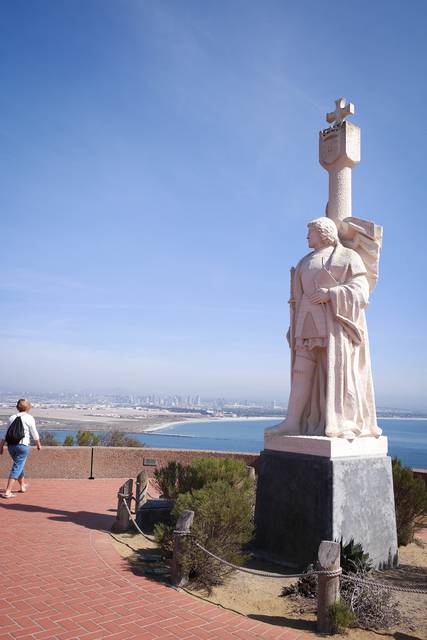 The area was long inhabited by the native Kumeyaay people (also known as the Diegueño by the later Spanish settlers), who lived off the land and created a proud culture. The first time a European visited the region was in 1542, when Portuguese explorer Juan Rodriguez Cabrillo, sailing under the Spanish flag, claimed the bay for the Spanish Empire and named the site San Miguel. In November 1602, Sebastián Vizcaíno was sent to map the California coast. Arriving with his flagship "San Diego", Vizcaíno surveyed the harbor and what is now Mission Bay and Point Loma, renaming the area for the Spanish Catholic saint, St. Didacus (more commonly known as San Diego).
The area was long inhabited by the native Kumeyaay people (also known as the Diegueño by the later Spanish settlers), who lived off the land and created a proud culture. The first time a European visited the region was in 1542, when Portuguese explorer Juan Rodriguez Cabrillo, sailing under the Spanish flag, claimed the bay for the Spanish Empire and named the site San Miguel. In November 1602, Sebastián Vizcaíno was sent to map the California coast. Arriving with his flagship "San Diego", Vizcaíno surveyed the harbor and what is now Mission Bay and Point Loma, renaming the area for the Spanish Catholic saint, St. Didacus (more commonly known as San Diego).
San Diego was established in 1769 as the first European settlement and Spanish mission in California, at the present site of Old Town. However, due to the poor nature of soils in the Old Town area, the mission was eventually relocated about 5 miles up river in Mission Valley. The mission had a troubled history, seeing bloodshed between the Spanish missionaries and natives resisting conversion, and the settlement didn't grow far beyond a few hundred people owing to the fact that it was too far from navigable water.
In the 19th century, San Diego passed from Spanish to Mexican to American hands. In 1850, a few years after the United States gained control of California, San Diego was officially designated a city. But with much of the westward expansion to California centered on the gold rush around San Francisco, American influences were slow to come to San Diego. Eventually they did, however, and in the 1860s Downtown was established on the shores of the bay, soon exploding in growth when the railroad arrived in the 1880s and developing into a major port. The city celebrated the opening of the Panama Canal in 1914 with a huge exposition touting San Diego's prominence and history; the fairgrounds, buildings, and exhibits of that expo formed the basis for today's Balboa Park and San Diego Zoo.
The U.S. Navy discovered San Diego in the early 20th century, and constructed a coaling station on Point Loma in 1907. Ten years later, the Naval Air Station on Coronado island was established, and in later years the military would take on an increasingly important role in the city's economy, peaking with World War II, when the city's ship building yards and naval base made San Diego one of the busiest ports on the west coast. Today, San Diego is still home to the Navy's Pacific Fleet and is a favorite leave location for many sailors.
Growth in San Diego has exploded and the economy has shifted away from its maritime and military roots. The defense industry still plays a big role here, but it is now rivaled by tourism, trade, biomedical laboratories and research, with many corporations moving their headquarters here amid the huge influx of residents. San Diego is a favorite destination for retirees and tourists, drawn by the balmy weather and the many attractions the city has to offer.
The San Diego area can be an incredible place to visit almost any time of the year. With coastal temperatures around 75 °F (24 °C) most of the time, the weather is ideal. The climate of Southern California is rather complex, however, and temperatures change rapidly as one travels from the coast eastward. In the summer during the day, the temperature might increase as much as one degree Fahrenheit for each mile going east. In the winter, especially at night, eastern areas are usually relatively cooler. Some valleys and other areas have significantly different weather due to terrain and other factors. These are often referred to as "micro-climates".
If you're coming to San Diego expecting sunny weather, avoid coming in May or June, when San Diego is covered in clouds most days, a phenomenon referred to by the locals as "May Grey" or "June Gloom". September is usually the hottest month of the year in the daytime. Mid-September through October are labeled as the most at-risk months for wildfires, because of the long absence of any substantial rainfall. Along the beach during the warmer half of the year, it can get surprisingly cool after dark, even when it's not too cold a short distance inland. The months of March and April typically see the strongest winds. Along the coast, fog is most common September through April; it is not uncommon to experience 3-7 foggy days per month.
During the late summer and fall there is a reversal of the usual climate conditions, when hot, dry air blows from the desert to the coast. These winds are called the Santa Ana winds. Milder Santa Ana winds can result in excellent dry air conditions, but powerful ones can last days on end, significantly raising temperatures, creating tremendous fire danger, and making the outdoors unpleasant.
- International Visitor Information Center, 1140 North Harbor Drive (in Downtown, in front of the B Street Cruise Ship Terminal, +1 619-236-1212. Daily 9AM-5PM (June-September); daily 9AM-4PM (October-May).
- La Jolla Village Information Center, 1162 Prospect Street, +1 858-454-5718. Daily 10AM-6PM (summer); daily 11AM-4PM (winter).
International Visitor Information Center, 1140 North Harbor Drive (in Downtown, in front of the B Street Cruise Ship Terminal, +1 619-236-1212. Daily 9AM-5PM (June-September); daily 9AM-4PM (October-May).
La Jolla Village Information Center, 1162 Prospect Street, +1 858-454-5718. Daily 10AM-6PM (summer); daily 11AM-4PM (winter).
See San Diego with children for travelers with children.
A couple of combination passes are available which offer discounted admission to multiple attractions:
- Go San Diego Card. Covers admission and express entry to over 40 attractions, including Sea World San Diego, Legoland California, San Diego Zoo, San Diego Zoo Safari Park, USS Midway Museum, Birch Aquarium, and all Balboa Park museums.
- Southern California CityPass. Gives you one day each at SeaWorld San Diego, Legoland California, and a 3-day park hopper ticket for Disneyland, as well as one-day admission to either the San Diego Zoo or the San Diego Zoo Safari Park for an additional fee if purchased online.
 One of San Diego's main claims to fame is its array of renowned zoological attractions which are at the forefront in the wildlife conservation movement. Of them, the most respected is the San Diego Zoo, a massive zoo that encompasses over 100 acres of Balboa Park and is possibly the premier zoo in North America. One of the earliest adopters of naturalistic animal exhibits, this is also one of the most gorgeous zoos in the world. Animal shows run constantly, and there are creatures here that aren't visible in any other zoo on the planet. It's definitely worth a visit, but you need a full day to really do it justice.
One of San Diego's main claims to fame is its array of renowned zoological attractions which are at the forefront in the wildlife conservation movement. Of them, the most respected is the San Diego Zoo, a massive zoo that encompasses over 100 acres of Balboa Park and is possibly the premier zoo in North America. One of the earliest adopters of naturalistic animal exhibits, this is also one of the most gorgeous zoos in the world. Animal shows run constantly, and there are creatures here that aren't visible in any other zoo on the planet. It's definitely worth a visit, but you need a full day to really do it justice.
The sister park to the San Diego Zoo and another stellar attraction in its own right, the San Diego Zoo Safari Park covers 1800 acres of the San Pasqual Valley, about 30 miles (50 km) north of Downtown San Diego near Escondido. Here the wide open expanse of the desert valley has enabled the creation of stunningly huge exhibits that resemble African savanna, where herds of animals roam and drink from watering holes. Like the Zoo, the Safari Park is also well worth a trip, but also requires a full day to take it in.
Considerably smaller but also important in its own right is the Birch Aquarium in La Jolla, the public face of the renowned Scripps Institute of Oceanography. The Birch holds fantastic exhibits which cover physical oceanography and plenty of beautiful aquarium fish, with highlights including a touchpool and a massive kelp tank that is a simulation of ocean life just off the San Diego coast. Less scientifically renowned but popular in its own right is Sea World on Mission Bay, the California branch of the marine theme park chain with its numerous animal shows and enclosures showcasing sharks, penguins, polar bears, dolphins, and killer whales among other marine animals. Also in the area and something of a hidden gem is the Living Coast Discovery Center, a nature center in the marshes of San Diego Bay in Chula Vista with a lot of interactive exhibits on the native wildlife.
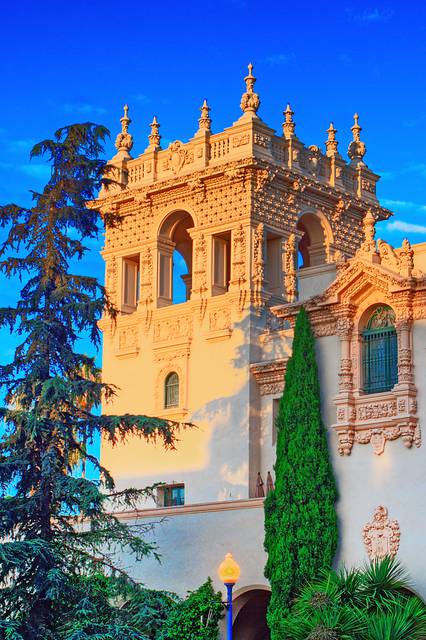 In addition to the zoo, Balboa Park is home to an expansive campus of intriguing museums, flowering gardens and beautiful arboretums set amidst neo-classical Spanish architecture, making it a must-visit for any trip to San Diego. Among the highlight attractions are the San Diego Museum of Art, merely the largest of several art museums within the park, the San Diego Museum of Man with its exceptional anthropological exhibits, the San Diego Air and Space Museum with its numerous historical aircraft and full-scale models, the Reuben H. Fleet Science Center and the San Diego Natural History Museum with their kid-friendly interactive exhibits, and the very fun San Diego Model Railroad Museum.
In addition to the zoo, Balboa Park is home to an expansive campus of intriguing museums, flowering gardens and beautiful arboretums set amidst neo-classical Spanish architecture, making it a must-visit for any trip to San Diego. Among the highlight attractions are the San Diego Museum of Art, merely the largest of several art museums within the park, the San Diego Museum of Man with its exceptional anthropological exhibits, the San Diego Air and Space Museum with its numerous historical aircraft and full-scale models, the Reuben H. Fleet Science Center and the San Diego Natural History Museum with their kid-friendly interactive exhibits, and the very fun San Diego Model Railroad Museum.
Amidst Downtown San Diego's restaurants and nightlife is the historical district of Gaslamp Quarter, home to plenty of Victorian-era buildings that have been re-adapted to other uses. Nearby along the Downtown waterfront are two museums devoted to the city's maritime heritage: the San Diego Maritime Museum, with a collection of lovingly restored 19th-century sailing ships, a steam ferryboat, and a former Soviet Union submarine, and the USS Midway Museum, a former aircraft carrier of the US Navy that is now open for tours and home to a collection of former naval aircraft housed on the ship's expansive flight deck. Across the bay from Downtown is the independent community of Coronado, home to a major naval facility and very charming streets, as well as the gorgeous Hotel del Coronado, a high-class hotel constructed in the late 1800s and sitting on one of San Diego's cleanest beaches.
Old Town is the city's main historical district, with preserved buildings and icons of the Spanish heritage of San Diego and the Old West, from 19th-century cannons to the haunted Whaley House. Shopping and restaurants dot the area and living history performances regularly take place. Up Mission Valley from Old Town and another reminder of the city's Spanish heritage is the Mission San Diego de Alcala, the oldest of the California missions, founded in 1769 by Junipero Serra.
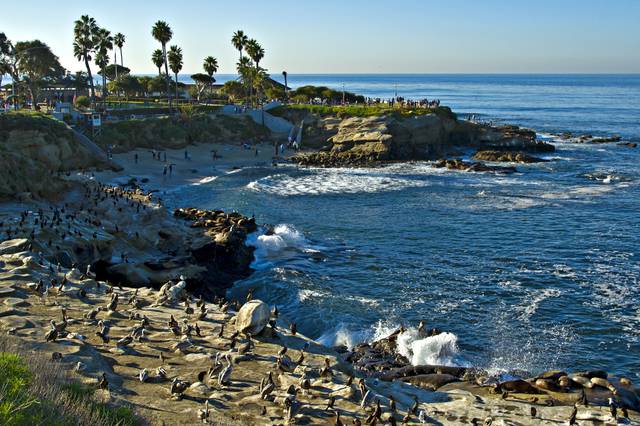 The San Diego coastline is rife with scenic attractions. Among the most spectacular is the view from Cabrillo National Monument at the tip of Point Loma. Created to commemorate the first California landing of Juan Rodriguez Cabrillo's expedition for Spain in 1542, the monument is situated atop a high vantage point at the mouth of the San Diego Bay, where visitors can get a panoramic view of Downtown San Diego, the bay, the ocean, and the distant mountains, as well as tour a historic former lighthouse and the remnants of WWII-era coastal defense structures. To the north, near Ocean Beach, is a stretch of scenic coastline known as Sunset Cliffs, with some secluded beaches and tidepools beneath the steep ocean cliffs.
The San Diego coastline is rife with scenic attractions. Among the most spectacular is the view from Cabrillo National Monument at the tip of Point Loma. Created to commemorate the first California landing of Juan Rodriguez Cabrillo's expedition for Spain in 1542, the monument is situated atop a high vantage point at the mouth of the San Diego Bay, where visitors can get a panoramic view of Downtown San Diego, the bay, the ocean, and the distant mountains, as well as tour a historic former lighthouse and the remnants of WWII-era coastal defense structures. To the north, near Ocean Beach, is a stretch of scenic coastline known as Sunset Cliffs, with some secluded beaches and tidepools beneath the steep ocean cliffs.
However, few places in Southern California can match La Jolla for coastal scenery. An upscale coastal community with dozens of coffee shops, restaurants and high-end shopping outlets, La Jolla also holds many secluded coves, beaches and ocean cliffs to explore, including the popular Children's Cove that has become a breeding ground for harbor seals. Just to the north of La Jolla proper is the scenic Torrey Pines State Natural Reserve, situated atop a plateau with steep ocean cliffs overlooking the beautiful (and relatively secluded) Torrey Pines State Beach; hiking trails lead you through the park to the beach below.
Further inland, away from the coast, the rugged, scrubby terrain of Northern San Diego offers some understated scenic attractions, including the Los Peñasquitos Canyon Preserve with its interesting rock formations and Mission Trails Regional Park, a hidden jewel that contains San Diego's highest point and a small gorge popular with rock climbers.
Go San Diego Card. Covers admission and express entry to over 40 attractions, including Sea World San Diego, Legoland California, San Diego Zoo, San Diego Zoo Safari Park, USS Midway Museum, Birch Aquarium, and all Balboa Park museums.
Southern California CityPass. Gives you one day each at SeaWorld San Diego, Legoland California, and a 3-day park hopper ticket for [[Disneyland]], as well as one-day admission to either the San Diego Zoo or the San Diego Zoo Safari Park for an additional fee if purchased online.
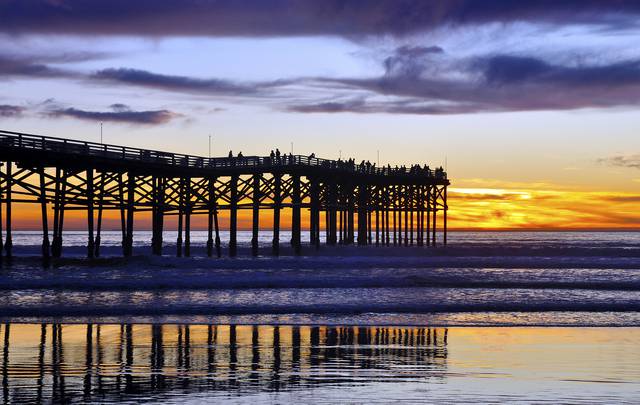 Along San Diego's coast you can find miles of beaches providing excellent opportunities for swimming, surfing, and general beach-going. Each beach is unique, ranging from popular white sand beaches to harsh surf spots to the clothing-optional Black's Beach in La Jolla. Surf conditions vary by beach, and there are numerous surf schools throughout the San Diego area.
Along San Diego's coast you can find miles of beaches providing excellent opportunities for swimming, surfing, and general beach-going. Each beach is unique, ranging from popular white sand beaches to harsh surf spots to the clothing-optional Black's Beach in La Jolla. Surf conditions vary by beach, and there are numerous surf schools throughout the San Diego area.
Among San Diego's beaches, Mission Beach and Pacific Beach are the most popular, with a connected boardwalk popular with bicyclists and roller bladers and plenty of shops, restaurants and bars catering to the huge crowds that show up, as well as a pier in Pacific Beach and a seaside amusement park on Mission Beach. This area tends to be the center of the Spring Break scene and has some of the calmest ocean swimming and surfing in San Diego, albeit also the most crowded.
To the south, Ocean Beach draws a more local crowd, with a large sandy beach, a fishing pier, and designated surfing and swimming zones, as well as a dog beach at the northern end, making it a good place to come if you want to get a taste of the local beach culture away from the crowds of Mission and Pacific Beaches. Further to the south, Coronado's main beach is noteworthy for its gleaming white sands and mostly family crowd, while the Silver Strand extending between Coronado and Imperial Beach has some excellent swimming and surfing spots.
To the north, La Jolla has some of the most scenic beaches around, including the popular La Jolla Cove, frequented by swimmers, snorkelers and scuba divers. Surfing is not allowed in the Cove, but the nearby Windansea Beach and Marine Street Beach are proven places to test your mettle against some rough surf. La Jolla Shores has some of the gentlest waves anywhere in San Diego, while Torrey Pines State Beach is arguably the most scenic, set against steep cliffs and a splendid place to get away from the crowds. Even further north, the coast of Northern San Diego County offers multiple scenic and popular beaches.
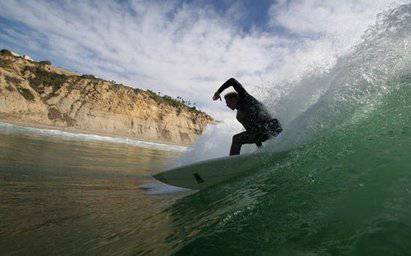 San Diego Bay offers amble opportunities for sailors to enjoy boating, with plenty of anchorages and marinas catering to all boaters. Launch ramps and marinas are located in Point Loma, Downtown, Coronado, National City and Chula Vista (see separate pages for specific places). Some anchorages require a permit, while others do not. If a permit is required, it can be obtained at the Shelter Island Harbor Police Facility in Point Loma (1401 Shelter Island Drive, +1 619-686-6272). There are also several moorings throughout the harbor for vessels ranging from two to 65 feet in length; see the SD Mooring Company Office on Harbor Island (near the airport; 2040 N. Harbor Island Drive, +1 619-291-0916) for a mooring application.
San Diego Bay offers amble opportunities for sailors to enjoy boating, with plenty of anchorages and marinas catering to all boaters. Launch ramps and marinas are located in Point Loma, Downtown, Coronado, National City and Chula Vista (see separate pages for specific places). Some anchorages require a permit, while others do not. If a permit is required, it can be obtained at the Shelter Island Harbor Police Facility in Point Loma (1401 Shelter Island Drive, +1 619-686-6272). There are also several moorings throughout the harbor for vessels ranging from two to 65 feet in length; see the SD Mooring Company Office on Harbor Island (near the airport; 2040 N. Harbor Island Drive, +1 619-291-0916) for a mooring application.
San Diego Bay and the calmer man-made inlet of Mission Bay are also excellent places for sailing, windsurfing, and jet skiing, with rentals and lessons offered on Mission Bay. The calm waters of Mission Bay also make it an excellent place for kayaking, with numerous rental places. Kayaking is also superb at La Jolla Shores, where you can see leopard sharks, dolphins, sea turtles, sea lions and pelicans, and explore ocean caves.
San Diego also features some great scuba diving, including the "Wreck Alley" where you can see kelp beds and explore the shipwrecks of the Yukon and the Ruby E. In addition, several dive boat operators offer regular runs to the Coronados Islands off the Mexican coast where you can dive with sea lions. Diving here is usually considered cold water diving and visibility is not always the greatest.
If you're looking for a more casual way to get on the water, there are also whale watching cruises. California gray whales migrate south along the coast each February, and there are some great places along the coast to view the migration, such as the overlook in Cabrillo National Monument (in Point Loma). Several private companies offer sailing tours during the migration season that bring you much closer to the whales.
- Hang gliding – At the edge of cliffs towering above the Pacific Ocean, the Torrey Pines Glider Port in La Jolla allows anyone to soar over one of the most pristine sections of coastline in southern California. Training and tandem glides with an expert are offered.
- Golfing – There are many public and private golf courses scattered throughout San Diego that suit nearly every budget. The Torrey Pines Golf Course in La Jolla hosts the PGA Tour Farmers Insurance Open annually in January or February.
- Hiking & biking - San Diego’s near perfect climate, unique landscape, and low-crime rate make it one of the most pleasant places in the country to enjoy outdoor exercise. Because of this, visitors and locals alike will have no trouble finding a biking, hiking, or walking trail to suit their needs. There are numerous hiking trails and bike paths to choose from - big and small, highly visible or hidden. Information on some of the most popular individual trails can be found in the district articles.
- Rock climbing - San Diego offers some unique opportunities for rock climbing both outdoor and indoor. Although San Diego is rarely considered a destination climbing area, specialist climbing companies offer guided rock climbing from professional climbers for the beginner to the experienced climber. All the climbing companies provide all the required equipment such as helmets, shoes and harnesses, and usually require an orientation meeting the week of the climb for all participants. Most good climbing spots are located either in North San Diego or Inland San Diego County.
Hang gliding – At the edge of cliffs towering above the Pacific Ocean, the Torrey Pines Glider Port in La Jolla allows anyone to soar over one of the most pristine sections of coastline in southern California. Training and tandem glides with an expert are offered.
Golfing – There are many public and private golf courses scattered throughout San Diego that suit nearly every budget. The Torrey Pines Golf Course in La Jolla hosts the PGA Tour Farmers Insurance Open annually in January or February.
Hiking & biking - San Diego’s near perfect climate, unique landscape, and low-crime rate make it one of the most pleasant places in the country to enjoy outdoor exercise. Because of this, visitors and locals alike will have no trouble finding a biking, hiking, or walking trail to suit their needs. There are numerous hiking trails and bike paths to choose from - big and small, highly visible or hidden. Information on some of the most popular individual trails can be found in the district articles.
Rock climbing - San Diego offers some unique opportunities for rock climbing both outdoor and indoor. Although San Diego is rarely considered a destination climbing area, specialist climbing companies offer guided rock climbing from professional climbers for the beginner to the experienced climber. All the climbing companies provide all the required equipment such as helmets, shoes and harnesses, and usually require an orientation meeting the week of the climb for all participants. Most good climbing spots are located either in [[San Diego/North|North]] San Diego or [[Inland (San Diego County)|Inland]] San Diego County.
_unfurl_the-sEsjE.medium.jpg) San Diego sports fans have always had a hard time of it. Despite being one of the largest cities in the country and blessed with beautiful weather, no major league professional team in San Diego has won a championship, and neither of the city's two current major college teams have won a national title in a popular sport. In fact, San Diego has more often been a place for professional athletes to play before moving on to legendary careers elsewhere. And not just athletes—whole teams have left San Diego, most notably the 2017 loss of the NFL's Chargers to Los Angeles.
San Diego sports fans have always had a hard time of it. Despite being one of the largest cities in the country and blessed with beautiful weather, no major league professional team in San Diego has won a championship, and neither of the city's two current major college teams have won a national title in a popular sport. In fact, San Diego has more often been a place for professional athletes to play before moving on to legendary careers elsewhere. And not just athletes—whole teams have left San Diego, most notably the 2017 loss of the NFL's Chargers to Los Angeles.
Nevertheless, one major league team still makes its home in San Diego: the San Diego Padres of Major League Baseball, who play at the lovely Petco Park in Downtown San Diego and who over their history have cultivated greats like Dave Winfield, Trevor Hoffman, and—of course—Tony Gwynn. This is also the birthplace of the San Diego Chicken, a widely beloved mascot whose popularity inspired a wave of cartoony mascots throughout American professional sports.
In collegiate sports, the San Diego State Aztecs, representing San Diego State University, are the city's most notable NCAA program, with the basketball team playing their home games at Viejas Arena on the SDSU campus in Mid-City, the baseball team playing at Tony Gwynn Stadium (also on the SDSU campus) and the football team playing at SDCCU Stadium in Mission Valley. Also in the city are the San Diego Toreros of the University of San Diego, with college basketball, baseball, and football teams playing at facilities located on the USD campus in Mission Valley.
San Diego is dotted with major shopping centers and upscale boutiques catering to nearly every style of dress and expression. The most well-known shopping centers in the area are Horton Plaza in Downtown, Fashion Valley and Westfield Mission Valley in Mission Valley and Westfield UTC near La Jolla. In addition to these, one can find numerous other malls and outlet centers across the city.
If you're more interested in smaller shops and more local businesses than you'd ordinarily find in your average mall, Downtown, Hillcrest, and the beach neighborhoods (Ocean Beach, Pacific Beach, La Jolla, etc.) offer a slightly more unique shopping scene. San Diego County has some unique antique markets, with a treasure trove of high end stores, as well as a host of second hand shops, bric a brac, and vintage stores.
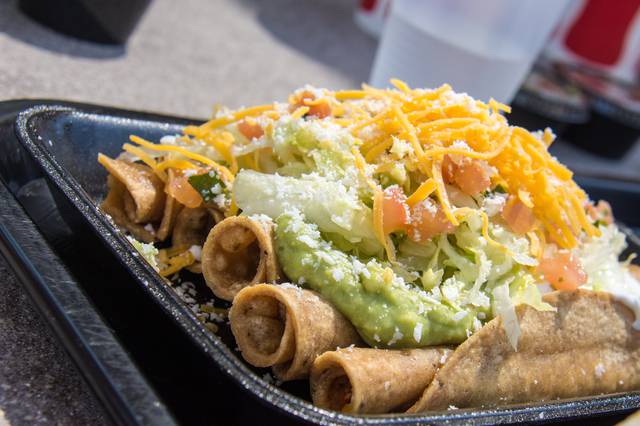
Like any large metropolitan area, San Diego offers a wide variety of national and international cuisine. Food representing almost every world cuisine can be found somewhere in the city, and major restaurant chains are found in almost every district. Some of the best districts for fine dining are Downtown, Hillcrest, and La Jolla, which all offer extensive options that cater to both a local and tourist crowd. Pacific Beach also has a bustling — albeit more laid-back — dining scene, while the neighborhoods of Mid-City (particularly Kensington and North Park) have plenty of great restaurants that cater to a more local crowd. Other food scenes of note in San Diego are the concentration of Italian restaurants and delis in Little Italy in Downtown and the numerous Southeast Asian restaurants and markets that serve the large Asian-American population in Kearny Mesa.
Given the proximity to the border, it should come as no surprise that Mexican food is abundant in San Diego. Be sure to look beyond the touristy (and generally overpriced) concentration of Mexican restaurants in Old Town; this city offers endless options for Mexican food, from hole-in-the-wall taco joints to fine dining. Ask a local for their opinion; every San Diegan has their favorite place. A local specialty is rolled tacos, which consist of beef or chicken tightly rolled into a corn tortilla and fried until crispy, then served with guacamole and shredded cheese piled on top. You can find them all over Southern California, but the best ones are to be found in San Diego, where they're ubiquitous. Other quintessential San Diego menu items not to be missed are fish tacos and the carne asada burrito; unlike other regional burrito varieties that tend to use rice and beans as filler, the San Diego variety is typically jam-packed with chunks of carne asada steak with some guacamole and pico de gallo mixed in, making for an immensely satisfying meal. A variant of the carne asada burrito is the California burrito, which contains carne asada, French fries, cheese, and some combination of cilantro, pico de gallo, sour cream, onion, or guacamole.
Bars and clubs can stay open past 2AM but are not permitted to sell alcohol after this time. Expect beer bars to be open until midnight and bars and clubs to call last call around 1:30-1:50AM. A medium-sized beer generally costs $4-5 in a restaurant. The best bar scenes in San Diego are in the Gaslamp Quarter area of Downtown and in Pacific Beach.
San Diego is well-known for its craft-brewing scene, with an emphasis on highly-hopped beers. Local brewers of distinction include AleSmith Brewing Company, Stone Brewing Company, Karl Strauss Brewing Company, Green Flash Brewing Company, Coronado Brewing Company, Ballast Point Brewing Company, and Port Brewing Company. Craft beer can generally be found at nearly every bar in San Diego. In addition, many specialty craft beer bars are scattered throughout San Diego, boasting some of the best and most unique selections of beer in the country.
Happy hour specials are very popular in San Diego, offering some of the best and cheapest deals on food and drink in the city. The Pacific Beach and Downtown areas are particularly known for their numerous bars and restaurants offering significant deals during happy hour.
The most common area code for San Diego Metropolitan area, including downtown, the southbay and the eastern suburbs is 619. North of I-8/Mission Valley uses 858, and the far northern suburbs (Escondido, Oceanside, Encinitas, etc.) use 760. Beginning June 2018, the area must be dialed with the phone number in all areas, i.e., 10-digit dialing is mandatory. Be sure to look when dialing a phone number that may be in a different area code. Most public telephones and hotel phones have the area code next to the phone number on the actual device.
There are numerous Wi-Fi hot spots in San Diego, many of which are at internet cafes. The San Diego Public Library system also offers wireless internet at all of its locations. If you're from out of state, ask for an "internet only" card, to avoid a $32 non-resident fee.
San Diego is considered to be one of the safest cities in California. Though crime is present, violent crime is on an overall decrease, but property crime still exists. You can now view real time crime reports of the area you plan to visit. One should use the same precautions as you would in any large metropolitan area. Avoid walking in Southeast San Diego or Barrio Logan (near or under the Coronado bridge) at night. If you do or must, avoid walking down dark alleyways or approaching unknown people. Most people do not encounter any problems if they avoid buying illegal drugs or prostitution. In addition, gangs are not as present as they are in Los Angeles, but they still exist.
In an emergency (immediate danger to loss of life or limb), call 911 to reach the Police Department, Fire Department, and/or to call for an ambulance. If you call from a cell phone, 911 calls are directed to the California Highway Patrol, which can result in delays in contacting city police. (911 calls made from land-line telephones are directed to the appropriate local agency.) 911 calls are free from all phones including pay phones.
In many cases, when within the city limits, it may be more appropriate to directly dial the San Diego non-emergency number, +1 619-531-2000. For example, to report a crime in progress when you are not in direct danger, it is probably best to call the San Diego Police (or other local municipality) directly.
San Diego is served by a professional police force as well as a county sheriff department. Additional protection is offered on the major highways by the California Highway Patrol (CHP). To report a non-emergency within city limits, call +1 619-531-2000.
The city of San Diego fire department offers fire protection, emergency medical care, hazardous waste cleanup, and search and rescue functions. If you dial 911 for an emergency the first responders will be the San Diego Fire Department. Urban brush fires are always a risk during the summer and fall, but rarely affect tourists.
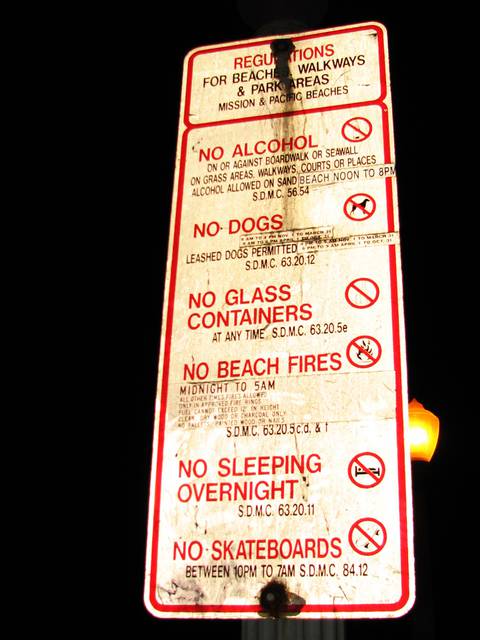 Rip currents are notorious in San Diego for their strength and sudden appearance. Do not go out in the water without lifeguard supervision or at night. At La Jolla Shores, rip currents can be so strong that people standing (not swimming) in waist-deep water have been pulled out over their heads -- sometimes with deadly results (especially for non-swimmers). Except for sunbathing, avoid low tide like the plague at this beach. (This means the largest of the two daily tide cycles. Check newspaper weather page for Scripps Pier, or view the Weather Channel.) All of the major beaches have lifeguards on duty in the summertime, with only the more popular beaches having lifeguards year round.
Rip currents are notorious in San Diego for their strength and sudden appearance. Do not go out in the water without lifeguard supervision or at night. At La Jolla Shores, rip currents can be so strong that people standing (not swimming) in waist-deep water have been pulled out over their heads -- sometimes with deadly results (especially for non-swimmers). Except for sunbathing, avoid low tide like the plague at this beach. (This means the largest of the two daily tide cycles. Check newspaper weather page for Scripps Pier, or view the Weather Channel.) All of the major beaches have lifeguards on duty in the summertime, with only the more popular beaches having lifeguards year round.
Many of the ocean cliffs are made of a compressed sandstone and are prone to collapse, even in dry weather. If walking along the cliffs at the beach, be 25 to 40 feet away, as they are unstable and dangerous. Obey all signs. Every year, there are a few serious injuries, and sometimes fatalities. Heavy rain may cause rising bacteria and chemical levels in the ocean waters. Care should be taken to read the newspapers or call the county health office to see if the water is safe for swimming. Generally, most people stay out of the water at the beaches for 24 to 72 hours after rain.
Access to the beaches is safely made by using any of the public stairways provided; they are well maintained (except at Black's Beach) and free. The stairs at Black's Beach are in disrepair, so use at one's own risk. Wear sturdy shoes, and don't try unless you are in very good physical condition and able to climb the 300 ft (100m) back from the beach. Beware of the false trails going down the cliffs, as every year a few people get stuck (or worse!). The trailhead begins at the southern corner of the unpaved glider port parking lot. Take a little time to familiarize yourself with the area and observe where others are going. Though a long walk, you can also get in from the north via Torrey Pines State Beach. ($10-12 Monday-Thursday; $12-20 Friday-Sunday and Holidays, or free along the highway.) High tide will cut off this route, so plan ahead.
The bridge that connects Torrey Pines (north of Black's Beach) with Del Mar (former Hwy US 101) is old and in need of repair. Avoid walking directly underneath, as pieces of concrete occasionally fall off. It's still considered safe enough to drive over for now. If concerned, access this area from the south via I-5 and Genesee Avenue (exit #29) which soon becomes N. Torrey Pines Rd. Always supervise children very closely at places such as Sunset Cliffs and the Torrey Pines Glider Port above Black's Beach. It may be necessary to hold their hand at all times. If you have unruly kids, don't go there.
Thefts do occur at the beach and can ruin a perfectly wonderful day. Do not leave any purses or other personal items of value alone on the beach or in an open car. Vehicle burglaries are more prevalent in most beach communities and take place in broad daylight. If possible, do not leave anything of value in your car even when locked. Most kayak and beach rental shops offer safe boxes free of charge, and will store your valuables while renting.
In addition, take caution when around certain beach areas, as you may wander (inadvertently) onto a military instillation, where security is tight and beaches are either reserved for military patrons and their families or training centers.
Alcohol is banned on all public beaches and coastal parks in the city of San Diego. Violators can be given up to a $250 fine, with repeat offenders fined up to $1,000 and six months in jail. The ban applies also to any sidewalk or street in the city of San Diego.
San Diego has no history of any major destructive earthquakes in modern times. The large San Andreas Fault that threatens San Francisco and Los Angeles runs far to the east here, and is actually closer to the Arizona border. Nevertheless, the smaller Rose Canyon Fault does run through San Diego. This has scientists concerned due to its proximity, even though it cannot produce a top-tier quake. When the "big one" hits LA, San Diego will be affected to some extent. Even if local damage is minimal, there will be supply shortages. You should take the same precautions as you would in any other area that potentially could have an earthquake someday.
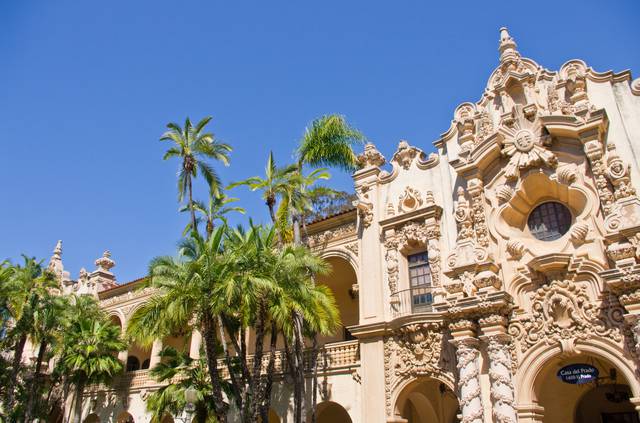
- San Diego Union-Tribune – The Union-Tribune is San Diego's main daily newspaper.
- San Diego Reader – A free weekly publication and the largest alternative paper in the city.
- San Diego CityBeat – An alternative free weekly paper.
- Voice of San Diego – A nonprofit, independent online newspaper.
- UCSD Guardian – A free student-operated newspaper at the University of California San Diego, published twice a week.
- North County Times – A daily paper focusing on issues facing the communities of Northern San Diego County.
- San Diego Magazine - A monthly publication.
San Diego Union-Tribune – The Union-Tribune is San Diego's main daily newspaper.
San Diego Reader – A free weekly publication and the largest alternative paper in the city.
San Diego CityBeat – An alternative free weekly paper.
Voice of San Diego – A nonprofit, independent online newspaper.
UCSD Guardian – A free student-operated newspaper at the University of California San Diego, published twice a week.
North County Times – A daily paper focusing on issues facing the communities of Northern San Diego County.
San Diego Magazine - A monthly publication.
There are numerous public and private hospitals in San Diego. These range from state funded institutions such as UCSD-Hillcrest and Thorton to private, world-renowned hospitals of Scripps La Jolla and the Children's Hospital. Non-profit Sharp Health Care also owns several hospitals, and has many "Urgent Care" centers for non-serious injuries such as a broken arm (daytime and early evening only). First-rate, world-class medical care can be found at any of these hospitals, as well as interpreters for more than a dozen languages.
San Diego is home to some of the most cutting edge health research in the country. The University of California, San Diego Medical Center is known for it's world class research. Some residents head to Mexico for cheaper health care, but this can be risky, and it would be more wise to use San Diego hospitals and clinics. Many of the institutions have doctors of all nationalities so language may not be a problem for some whose English skills may not be so good.
Smoking is banned in all restaurants, bars, public offices, and other places by order of California law, although smoking is allowed in tobacco shops and in coffee shops where tobacco is sold. There is a county wide ban on smoking in all state parks and there are city wide bans in San Diego, Del Mar, and Solana Beach that forbids smoking on public parks and beaches. El Cajon bans all outdoor smoking in public places. Smoking is also prohibited within 25 feet of any MTS transit station or bus stop, and those caught smoking near transit facilities will face a fine of $75.
Most consulates are honorary which means they offer limited services to travelers and their nationals living in the area and usually available by appointment only. They are typically located in downtown but can be elsewhere too. The nearest cities for additional foreign consulates are in Los Angeles and San Francisco:
- Canada Canada (Trade Office), 402 W Broadway Ste 400, +1 619-615-4286.
- Denmark Denmark (Honorary), 135 Liverpool Drive, Suite C, Cardiff, +1 760-942-9431.
- Germany Germany (Honorary), 1620 5th Avenue, Suite 500, +1 619-321-0606.
- Mexico Mexico, 1549 India St, +1 619-231-8414.
- Netherlands Netherlands (Honorary).
- Norway Norway (Honorary), 1940 Garnet Avenue, Suite 300, +1 858-274-3422.
Canada Canada (Trade Office), 402 W Broadway Ste 400, +1 619-615-4286.
Denmark Denmark (Honorary), 135 Liverpool Drive, Suite C, Cardiff, +1 760-942-9431.
Germany Germany (Honorary), 1620 5th Avenue, Suite 500, +1 619-321-0606.
Mexico Mexico, 1549 India St, +1 619-231-8414.
Netherlands Netherlands (Honorary).
Norway Norway (Honorary), 1940 Garnet Avenue, Suite 300, +1 858-274-3422.
- San Diego is probably the best city in America for making a quick trip to Mexico. Tijuana, which sits directly across the US - Mexico border, can be reached by public transit. The San Diego Trolley's Blue Line provides service from downtown San Diego to the border. The trip on the trolley takes about 45 minutes from downtown. Once you reach the end of the line (San Ysidro), follow the people and signs to the border crossing. It takes less than five minutes from the trolley stop to the border. Once across, it is either a 20-minute walk or a 5-minute cab ride to reach Av. Revolucion, the main tourist shopping street in Tijuana. If you take a car, avoid driving hassles and long waits when returning by parking in pay lots near the border and walking across. This also saves you the added expensive of purchasing Mexican insurance on the US side before you drive into Mexico. Be warned: it is illegal to drive your car or a rental car into Mexico without this type of insurance. Otherwise, taxis, buses, and private car hires are all available. If traveling to Tijuana Airport, the Mexican airline Volaris operates a bus service between that airport and San Diego's Santa Fe Train Depot.
- For a delightful, low-key alternative, drive 60 minutes on the American side to the small border crossing of Tecate (home of the Tecate brewery). It's a short walk to the town square. Coming back, the line is usually shorter here at the pedestrian crossing. You can easily combine a trip to the train museum in nearby Campo with a quick trip across the border for lunch!
- The greater San Diego County has a lot of smaller, more private beaches to the north (e.g., Del Mar and Encinitas). Del Mar has the largest county fair in the nation (June-early July), and horse racing mid summer to fall, plus November. There are also some great small towns to stay in and explore. Carlsbad, about 30 miles (50 km) north on I-5, is home to the popular Legoland California theme park. Further east, the Imperial Valley and the California Desert give a change of scenery.
- Julian is the largest and most popular mountain community in San Diego County. Also, nearby is Cuyamaca Rancho State Park and Palomar Mountain which has a large observatory. Beware, on hot summer days, the mountains are actually warmer than the city (as they're next to the desert).
- Temecula Wine Country is located about 60 minutes northeast of San Diego on I-15 and makes a good day trip. There are about 30 wineries (with tasting rooms) fairly close to each other. One hour further is the mountain resort of Idyllwild which features shopping and outdoor activities in an alpine forest.
- It's also relatively easy to get up to Los Angeles and other points in Southern California. Interstate 5 extends through the San Joaquin Valley of California, Oregon and Washington to the Canadian border. Although slower, California Route 1 (Highway 1 or Pacific Coast Highway in most of Southern California) and the US Route 101, through the Central Coast, Monterey Bay, and the San Francisco Bay Area, makes for more of a pleasant and fruitful trip. There is no gas/petrol or other services on I-5 between Oceanside and San Clemente for a distance of about 20 miles (32 km). (Entry to Camp Pendleton most often requires a DOD decal or military ID, though you always need commissary privileges to buy fuel.)
- There are no boats to Catalina Island (Avalon) within San Diego County. You'll have to go north into neighboring Orange County to the pier at Dana Point. By car, take I-5 to exit #79 Pacific Coast Hwy 1 (make reservations).
San Diego is probably the best city in America for making a quick trip to [[Mexico]]. [[Tijuana]], which sits directly across the US - Mexico border, can be reached by public transit. The San Diego Trolley's Blue Line provides service from downtown San Diego to the border. The trip on the trolley takes about 45 minutes from downtown. Once you reach the end of the line (San Ysidro), follow the people and signs to the border crossing. It takes less than five minutes from the trolley stop to the border. Once across, it is either a 20-minute walk or a 5-minute cab ride to reach Av. Revolucion, the main tourist shopping street in Tijuana. If you take a car, avoid driving hassles and long waits when returning by parking in pay lots near the border and walking across. This also saves you the added expensive of purchasing Mexican insurance on the US side before you drive into Mexico. Be warned: it is illegal to drive your car or a rental car into Mexico without this type of insurance. Otherwise, taxis, buses, and private car hires are all available. If traveling to Tijuana Airport, the Mexican airline Volaris operates a bus service between that airport and San Diego's Santa Fe Train Depot.
For a delightful, low-key alternative, drive 60 minutes on the American side to the small border crossing of [[Tecate]] (home of the Tecate brewery). It's a short walk to the town square. Coming back, the line is usually shorter here at the pedestrian crossing. You can easily combine a trip to the train museum in nearby Campo with a quick trip across the border for lunch!
The greater [[San Diego County]] has a lot of smaller, more private beaches to the north (e.g., [[Del Mar]] and [[Encinitas]]). Del Mar has the largest county fair in the nation (June-early July), and horse racing mid summer to fall, plus November. There are also some great small towns to stay in and explore. [[Carlsbad (California)|Carlsbad]], about 30 miles (50 km) north on I-5, is home to the popular Legoland California theme park. Further east, the [[Imperial County|Imperial Valley]] and the California [[Desert (California)|Desert]] give a change of scenery.
[[Julian]] is the largest and most popular mountain community in San Diego County. Also, nearby is Cuyamaca Rancho State Park and Palomar Mountain which has a large observatory. Beware, on hot summer days, the mountains are actually warmer than the city (as they're next to the desert).
[[Temecula]] Wine Country is located about 60 minutes northeast of San Diego on I-15 and makes a good day trip. There are about 30 wineries (with tasting rooms) fairly close to each other. One hour further is the mountain resort of [[Idyllwild]] which features shopping and outdoor activities in an alpine forest.
It's also relatively easy to get up to [[Los Angeles]] and other points in [[Southern California]]. Interstate 5 extends through the [[San Joaquin Valley]] of California, [[Oregon]] and [[Washington (state)|Washington]] to the [[Canada|Canadian]] border. Although slower, California Route 1 (Highway 1 or [[Pacific Coast Highway]] in most of Southern California) and the US Route 101, through the [[Central Coast (California)|Central Coast]], [[Monterey Bay]], and the [[Bay Area (California)|San Francisco Bay Area]], makes for more of a pleasant and fruitful trip. There is no gas/petrol or other services on I-5 between Oceanside and San Clemente for a distance of about 20 miles (32 km). (Entry to Camp Pendleton most often requires a DOD decal or military ID, though you always need commissary privileges to buy fuel.)
